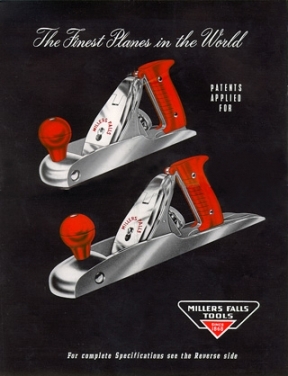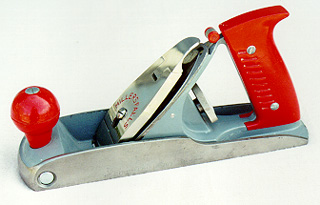The Buck Rogers Planes
 In early 1950, the Millers Falls Company distributed the circular at right to inform the hardware trade of its new Model 709 and 714 bench planes. The two planes were part of a group of twenty-four products that had not been included in the first printing of the company’s December 1949 catalog. The catalog, entitled Hand Tools, Portable Electric Tools, Hacksaws: Catalog 49, was later reprinted with a nine-page addendum that included the new tools.
In early 1950, the Millers Falls Company distributed the circular at right to inform the hardware trade of its new Model 709 and 714 bench planes. The two planes were part of a group of twenty-four products that had not been included in the first printing of the company’s December 1949 catalog. The catalog, entitled Hand Tools, Portable Electric Tools, Hacksaws: Catalog 49, was later reprinted with a nine-page addendum that included the new tools.
The 709 and 714 planes were well-designed, quality products. The handles and knobs were fabricated from Tennessee Eastman tenite #2 and were guaranteed unbreakable in use. The planes’ frog assembly provided a seating surface three to four times longer than that of a standard plane, and the heavier weight of the tool gave them an advantage when handling irregular grain. A great deal of thought went into the ergonomics of the lateral and depth adjustments with the result that the tool steel cutter is easy to set. The back side of the 1950 circular details eight points of quality that distinguish the plane and includes an illustration of the frog assembly.
The Millers Falls Company’s “Finest planes in the world” hyperbole aside, the tools were outstanding products—within their limitations. The models 709 and 714 were designed for general carpentry rather than fine woodworking. The mouth is too wide to allow for fine work, and the movable frog lacks an external adjustment screw. Promotional literature stressed greater, freer chip and shaving clearance, a feature of little concern to someone making the thin shavings characteristic of precision woodworking.
The design
The planes were designed by Robert W. Huxtable, the brother of noted industrial designer L. Garth Huxtable and a draftsman for the Millers Falls Company. The No. 709 plane, pictured at the top of the circular, is a smoothing plane. The No. 714 at bottom is a jack. Robert Huxtable’s design was a re-work of a tool developed by Samuel Oxhandler for the Sargent Company of New Haven, Connecticut. Oxhandler’s tool was never produced, and the streamlined Millers Falls planes were not copied by other manufacturers.
The planes have been nicknamed “Buck Rogers” planes by tool collectors, and the term has been adopted to refer to other Millers Falls tools of similar vintage and aesthetic.
Buck Rogers plane type study

Type 1. (1949/50-195?)
- 1. The model featured in the second printing of the October 1949, Millers Falls catalog.
- 2. The nose of the plane slopes gently downward in an uninterrupted curve to the sole.
- 3. There is no paint forward of the throat.
- 4. The horn of the tote is roughly parallel to the sole.
- 5. Screw holding front knob to body may or may not be slotted.

Type 2. (195?-1960)
- 1. Not pictured in any Millers Falls catalog.
- 2. Changes from the type one are purely cosmetic.
- 3. The top surface of the body surrounding the knob, is recessed and painted gray.
- 4. The horn of the tote angles upward.
- 5. Screw holding front knob to body is slotted.
Note: The Type 2 version of the No. 714 jack plane is the least common of the four variants.